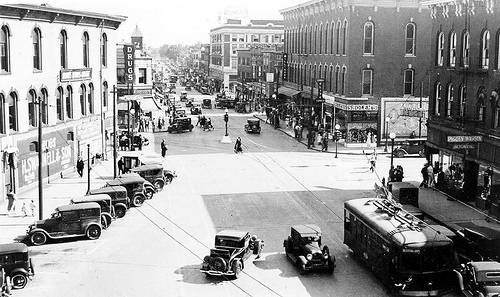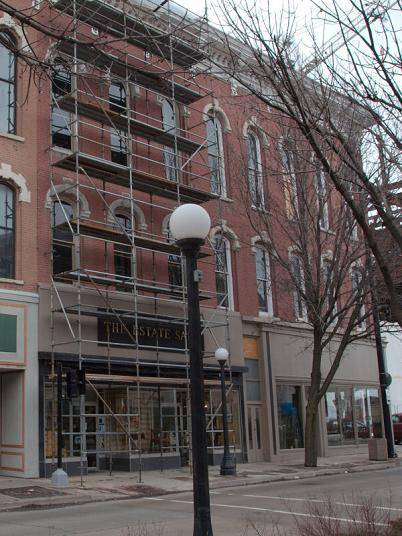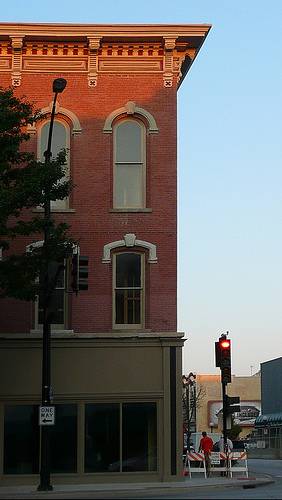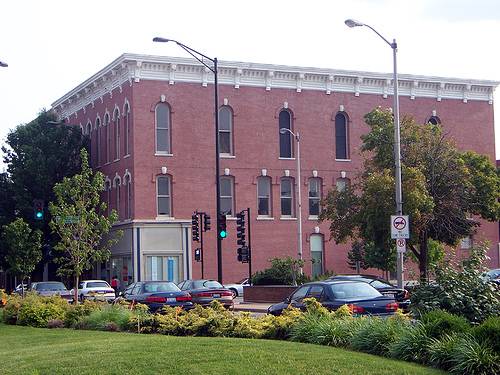These are the Buildings in Your Neighborhood will examine the history and the future of significant buildings around Champaign-Urbana. This column will focus on answering three main questions:
- For what purposes was the building constructed in the first place?
- What businesses have come and gone during the building’s history?
- What do the current owners of the property want to bring to the Champaign-Urbana community now & in the future?
- If there is a vacuum of vision and leadership, what might we as citizens of these two cities consider doing
 with these beautiful old spaces?
with these beautiful old spaces?
The pilot column will focus on the Metropolitan Building, 219-225 N. Neil Street in Champaign, which burned to the ground in the early morning of November 7, 2008. Thankfully, no one was hurt and the adjacent streets are again safe to walk, bike and drive. However, losing such a wonderful old building leaves a hole in downtown Champaign, both literally and figuratively, and the property’s future is unwritten. So this article will focus on the history of what once was with a view towards inspiring dreams about what might one day rise from new foundations at the southwest corner of Neil and Church.
The proper name of the building that stood there is not the Metropolitan Building. When it was placed on the National Register of Historic Places in 1997, the edifice was listed as the Bailey-Rugg Building. That name comes from the two merchants who went in together on its construction in the 1860s, David Bailey and  Daniel Rugg. Rugg began the project by buying the frame building that previously occupied the lot in 1863 and moving his boot & shoe store there. Bailey, who owned the frame structure immediately to the south facing Neil, then joined in on Rugg’s plans for a large Italianate brick building to replace their two smaller buildings. The two men laid the foundations in 1871 and the building was completed six months later.
Daniel Rugg. Rugg began the project by buying the frame building that previously occupied the lot in 1863 and moving his boot & shoe store there. Bailey, who owned the frame structure immediately to the south facing Neil, then joined in on Rugg’s plans for a large Italianate brick building to replace their two smaller buildings. The two men laid the foundations in 1871 and the building was completed six months later.
As the year ended, the Champaign County Gazette, one of the two predecessor newspapers to today’s News-Gazette, called for a common name for the row of buildings that now included the Bailey-Rugg Building. In their December 6 edition, they proudly announced the fruits of their civic boosterism:
… Messrs. Walker Bros., David Bailey and D. Rugg, took into consideration a proper cognomen for the elegant three-story block but lately erect by them on Neil Street. Upon the suggest of Mr. L.W. Walker, it was named the Metropolitan Block… Hurrah for the Metropolitan!
But the editors found themselves forced to quickly backtrack:
The Walker Bros. request us to say that the name was announced without their consent or agreement and they will not permit their part of the row to “sail” under the name. We are sorry that any misunderstanding exists….
The Walker Building still stands immediately to the south, though it was badly damaged by the fire. Its most recent occupant was the law firm of Dobbins, Fraker, Tennant, Joy & Perlstein, which partially owns the structure. As of the time of writing, its fate is unclear.
 |
| This picture was taken in 2008, shortly before the fire on November 7. The corner Church storefront lies on the right hand and the Neil storefront is in the middle with the scaffolding in front. The seam running down the left hand side of the photo where the color of the brick changes slightly indicates the division between the Bailey-Rugg Building and the Walker Building. |
As 1872 dawned, Faulkner’s Drugs occupied the The Metropolitan’s Church Street storefront on the corner and Rugg’s boot and shoe store moved in just to the south. The original tenant for the south Neil storefront adjacent to the Walker Building is unknown. These two anchor stores remained in the space for about seven years until Rugg’s shoe store closed up shop. F.K. Robeson took up the slack, opening Robeson’s Dry Goods at some point after 1878. Robeson prospered so much that his business quickly expanded south into the Walker Building. But even these two spaces together could not hold all the wonderful things he sold, so Robeson built a new store one block west of the Bailey-Rugg Building at the corner of Church and Randolph. That space, which was Robeson’s Department Store for many decades, is now divided into offices. Robeson operated both stores in parallel up until sometime in the 1920s, when his business consolidated in the new building.
Though the businesses occupying the first floor storefronts were quite stable through the turn of the 20th century, the second and third floors saw a motley assortment of businesses and fraternal organizations. An opera house occupied the southern half of the third floor on the building’s opening, but quickly folded. The third floor was then held down by the Masons and the Independent Order of Odd Fellows, the latter now sadly defunct. In 1898 and 1884, respectively, these two lodges built their own halls. The Masons’ hall still stands. It’s the Jefferson Building at the corner of Hill & Randolph in Champaign.
Bailey and Rugg sold the building to Charles Hamilton in 1915. Hamilton had visions for a grand hotel and made some substantial renovations in 1919 and 1920 to that end. However, S.C. Tucker, a pharmacist who had taken over the Faulkner Drugs store in 1903, held out long enough to scuttle Hamilton’s plans. These renovations held the building over as a vital center of commerce in downtown Champaign through the mid-1970s. A number of women’s clothing stores came and went, the longest tenured of which were Lane’s in the south Neil storefront from the mid-1950s to 1970 and Newman’s Fashions in the corner Church storefront from 1935 to 1968. In the 1960s, the owners covered up many of the original architectural features. The second and third floors were largely abandoned at this point; one of the last occupants was a campaign office for Dwight Green’s gubernatorial race. Green was Governor of Illinois from 1941 to 1949.
The chain of ownership is unclear after Hamilton’s scheme fell through, at least so far as the author’s research indicates, but the Metropolitan Building reverted into the hands of the Rugg family in 1956, when Robert Tilden, Daniel Rugg’s great-grandson, brought it back into the family. Tilden lived in Wisconsin, so the Metropolitan suffered from the inevitable lack of attention inherent to absentee ownership. As downtown Champaign declined as a shopping area, the retail portions of the Metropolitan Building shifted their focus towards the bar scene. Rafaelle’s, a restaurant and bar, opened in the corner space in the early 1980s. Later, the proprietor brought in a partner who asked to have the bar renamed after him, and so it became known as Mr. Poochie’s.
The 1990s brought some new vitality to the Metropolitan when Cody Sokolski moved Periscope Records from the Old Farm shops at Kirby & Mattis into the Neil storefront. In addition to the retail store, hub of the burgeoning Sokolski empire, the space also hosted concerts by local bands like the Funky Butt Drum Club and touring bands like Moxy Fruvous. Robert Tilden applied to have the building placed on the National Register of Historic Places around this time as well. The status was granted by the National Park Service in 1997.
Tron Fu purchased the building in 2002 and moved his Internet service provider, Sol Tec, into the first floor. On purchasing the Metropolitan, Fu aimed to perform substantial renovations, but in the next few years, Pavlov Media bought out Sol Tec and Mr. Fu abandoned the project. Jeff Mellander, Bob Balisrud and George Grubb picked up the torch in 2006. They began an extensive restoration of the Metropolitan. The second and third floors, which were being renovated into condos, were nearing completion when the fire took the building from them and from all of us.
So now the Metropolitan Building consists of one prime location, one pile of rubble, one reasonably large check from an insurance company (one presumes, at least) and the vision of Mellander, Balisrud & Grubb. According to PACA, Mellander thoroughly documented the building over the past three years, so a reconstruction is possible. The three owners will be the prime movers, of course, but my question to all of you readers is this: What do you want to see there?
Special thanks to the Champaign County Historical Archives, PACA, the News-Gazette (particularly Phil Bloomer & Mike Monson), Mike Feldman, & Art King for information and guidance about the history of the Metropolitan Building. Also, thank you to Adam for the use of photos out of his Flickr stream. You can find much more of his excellent photography at http://www.flickr.com/photos/army_arch. Much love to Adrianne Fabello for her inspiration and encouragement.









 with these beautiful old spaces?
with these beautiful old spaces?